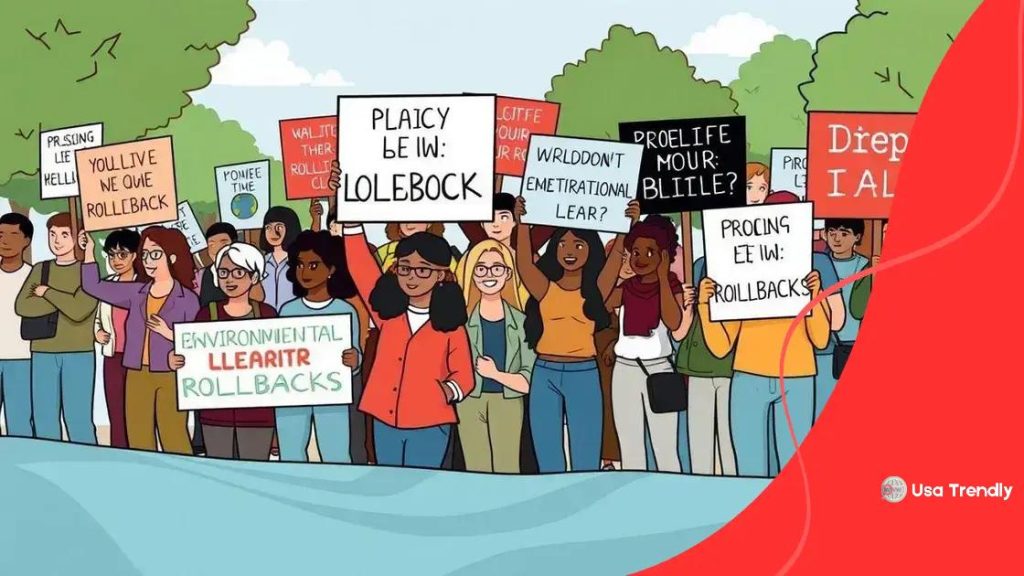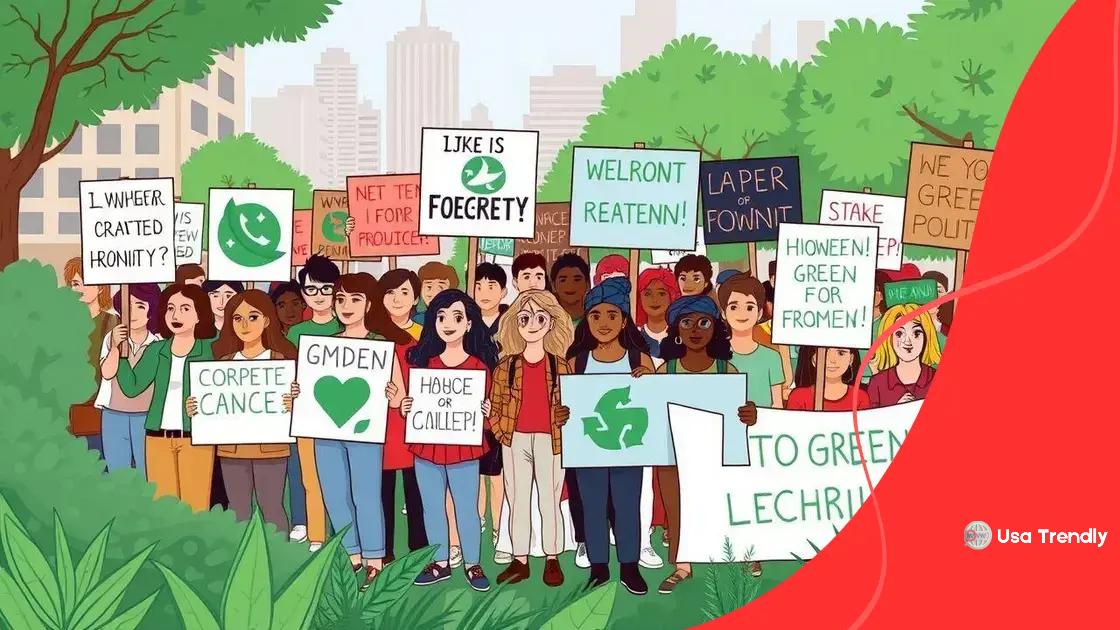Rollbacks in green policies draw criticism as backlash grows

Rollbacks in green policies draw criticism as they threaten sustainability efforts, increase emissions, and impact public health, highlighting the need for stronger environmental legislation worldwide.
Rollbacks in green policies draw criticism for their potential to undermine years of progress in climate action. Many wonder how these changes affect our environment and future. Let’s delve into this pressing issue.
Understanding recent rollbacks in green policies
Understanding the recent rollbacks in green policies is essential as these changes can have significant environmental impacts. Many governments around the world have made decisions that reverse progress in sustainability.
Key Drivers of Rollbacks
One major factor driving these rollbacks is economic pressure. During tough economic times, leaders often prioritize immediate economic growth over long-term environmental goals. This shift can lead to decreased funding for renewable energy projects and reduced regulatory oversight.
Political Influences
Political agendas also play a crucial role. Leaders may support policies that favor industries such as fossil fuels, which often lobby for less regulation. This political support for traditional energy sources often comes at the cost of green initiatives.
- Economic priorities often overshadow environmental protections.
- Lobbying from traditional energy industries can lead to policy changes.
- Public opinion can shift, influencing political decisions.
International relations can further complicate the situation. Countries that rely on environmental pacts might find themselves in difficult negotiations, especially if other nations are not honoring their agreements. The funding and partnerships that support green policies become strained, which can lead to further rollbacks.
Impacts on Communities
The rollback of green policies often results in immediate and visible effects on communities. Pollution levels can rise, impacting public health and quality of life. When regulations are relaxed, industries often take advantage, increasing emissions that can harm both the environment and human health.
In summary, understanding these rollbacks provides insight into the ongoing challenges in combating climate change. The effects ripple through our daily lives, influencing everything from the air we breathe to the sustainability of our planet.
Analyzing the impacts on climate change
Analyzing the impacts on climate change is crucial to understanding the consequences of recent rollbacks in green policies. As these policies are reversed, the effects on our planet can be both immediate and long-term.
Increased Emissions
One of the most significant impacts of policy rollbacks is the rise in greenhouse gas emissions. Industries may take advantage of relaxed regulations, leading to increased pollution. This change can exacerbate climate change, contributing to more severe weather patterns and rising temperatures.
Effects on Biodiversity
The rollback of environmental protections can also threaten biodiversity. As habitats are destroyed or degraded, many species struggle to survive. This loss of biodiversity can diminish ecosystem resilience, making it harder for nature to adapt to climate change.
- Increased pollution levels harm wildlife.
- Reduction in protected areas puts species at risk.
- Ecosystem services, like clean air and water, become compromised.
The connection between policy and climate action is evident. When governments prioritize short-term economic gains, they often ignore the long-term consequences for the environment. This focus can hinder efforts to reduce carbon footprints and mitigate climate change impacts.
Public Health Concerns
Furthermore, the impacts on climate change have direct implications for public health. Increased pollution levels can lead to respiratory diseases and other health issues in communities. As more pollutants enter the air, the overall quality of life decreases, putting vulnerable populations at even greater risk.
This analysis highlights the importance of maintaining strong environmental policies. As we consider the future, it’s vital to understand how these rollbacks affect not just the environment, but also human health and well-being.
Public response to green policy changes

The public response to green policy changes has been varied, as people express their concerns and hopes regarding environmental issues. Many individuals are deeply concerned about the negative impacts that rollbacks may have on both the planet and their communities.
Grassroots Movements
One significant aspect of the public response has been the rise of grassroots movements. Numerous organizations and activists are mobilizing to advocate for stronger environmental protections. These groups often hold rallies, raise awareness through social media, and engage with local communities to encourage action.
Concerns Over Climate Impact
Many citizens fear that the rollback of green policies could lead to severe environmental consequences. This concern is particularly notable among younger generations who realize they will face the long-term effects of climate change. Polls indicate that a large percentage of the population supports policies aimed at reducing emissions and transitioning to renewable energy sources.
- Public protests reflect widespread concern for the environment.
- Increased participation in community clean-up efforts.
- Calls for transparency in government practices regarding environmental policies.
While some segments of the population support these rollbacks, viewing them as beneficial for economic growth, many counter that the potential harms far outweigh any short-term benefits. The debate often highlights the tension between immediate economic needs and sustainable practices.
The Role of Social Media
Social media has played an essential role in shaping public opinion. Platforms like Twitter and Facebook enable quick dissemination of information, allowing movements to grow rapidly. People share personal stories about environmental impacts, influencing others to join the conversation.
In conclusion, the response to green policy changes is a complex mix of advocacy, concerns, and public sentiment. As this dialogue continues, it will be critical for leaders to engage with their constituents and consider the long-term implications of their policy decisions.
Comparing global approaches to sustainability
Comparing global approaches to sustainability reveals how different countries handle environmental challenges. Each nation tailors its strategies based on unique resources, economies, and public needs.
Developed vs. Developing Countries
In developed nations, sustainability efforts often focus on advanced technologies and regulations. These countries invest heavily in renewable energy sources like solar and wind. They also implement strict policies to reduce emissions and promote green practices. Conversely, developing nations face unique obstacles. They may prioritize economic growth and immediate needs over long-term sustainability. Here, sustainability initiatives might include community-based projects that focus on local resources and needs.
International Agreements
Global agreements, like the Paris Agreement, aim to unify efforts across countries. This agreement encourages countries to set emissions reduction targets and share progress. However, compliance varies significantly. Some countries actively meet their goals, while others fall behind due to economic or political challenges.
- Developed countries often lead in technology and funding.
- Developing nations focus on community engagement and resource management.
- International agreements provide frameworks for collaboration.
In recent years, innovative approaches like circular economies have gained traction worldwide. This model focuses on reducing waste and promoting resource reuse, creating a more sustainable economic system. Some countries, especially in Europe, have embraced this strategy widely.
Case Studies
Looking at specific case studies can illustrate these differences further. For instance, Denmark leads in wind energy adoption, powering a significant portion of its energy needs through renewable sources. On the other hand, countries like India are rapidly investing in solar energy to meet their rising demands while balancing economic growth.
In summary, understanding these global approaches highlights the diversity of strategies to achieve sustainability. Each nation’s method reflects its unique context, challenges, and goals, making the landscape of sustainability rich and complex.
Future of environmental legislation
The future of environmental legislation is a critical topic as governments around the world strive to create sustainable policies that protect the planet. With increasing awareness of climate change, many are pushing for stronger laws and regulations that address environmental concerns.
Shifting Priorities
As public concern for the environment grows, legislators are beginning to recognize the need for change. Many countries are looking to implement stricter emissions standards and promote renewable energy usage. This shift is driven by the desire to meet international commitments, such as those made in the Paris Agreement.
Emphasis on Sustainability
Future legislation is likely to focus on sustainability as a core principle. This includes implementing measures that support green infrastructure, promote conservation, and enhance biodiversity. Policymakers are increasingly aware that environmental health is interconnected with human health and economic stability.
- Development of clean energy technologies to reduce reliance on fossil fuels.
- Incentives for businesses that adopt sustainable practices.
- Stronger regulations on pollution and waste management.
Technological advances also play a significant role in shaping future policies. Innovations in areas like waste management, carbon capture, and energy efficiency are becoming crucial components of effective legislation. As technologies improve, they offer new solutions to long-standing environmental challenges.
International Collaboration
Global collaboration is vital for addressing environmental issues. Countries must work together to share solutions and resources. This collaboration often leads to treaties and agreements that set common goals for environmental protection.
In summary, the future of environmental legislation is likely to become increasingly robust, fueled by technological advancements and a growing public demand for accountability and results. As governments adapt to both domestic and international pressures, they must prioritize sustainable practices to ensure a healthier planet for future generations.
In conclusion, the future of environmental legislation is promising as more awareness about sustainability grows. Governments are increasingly prioritizing policies that protect the planet and public health. Innovations in technology will continue to play a pivotal role, making it easier to implement effective solutions. Furthermore, global collaboration will be essential in addressing environmental challenges, fostering a shared commitment to a healthier and more sustainable future. By uniting efforts, we can work towards meaningful change that safeguards our environment for future generations.
FAQ – Frequently Asked Questions about Environmental Legislation
What is the future of environmental legislation focused on?
The future of environmental legislation is focused on sustainability, prioritizing policies that protect the planet and public health.
How does technology influence environmental policies?
Technological advancements play a crucial role in shaping effective environmental policies by providing innovative solutions to long-standing challenges.
Why is global collaboration important for environmental issues?
Global collaboration is essential for addressing environmental challenges, allowing countries to share resources and strategies for better outcomes.
What are some key measures for sustainability in legislation?
Key measures include stricter emissions regulations, promoting renewable energy, and implementing practices that foster biodiversity and conservation.
SEE MORE CONTENT